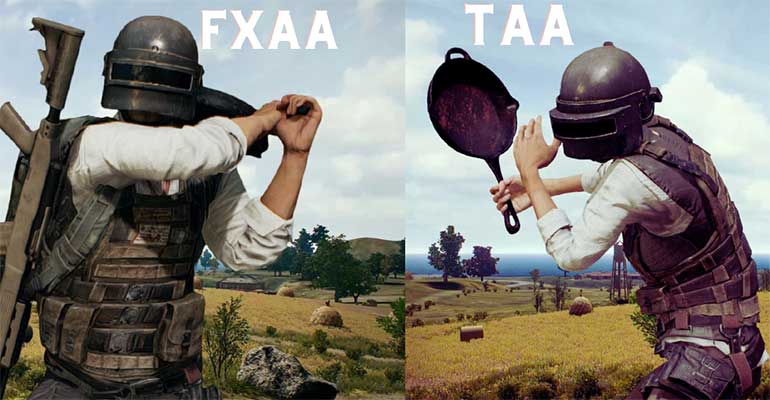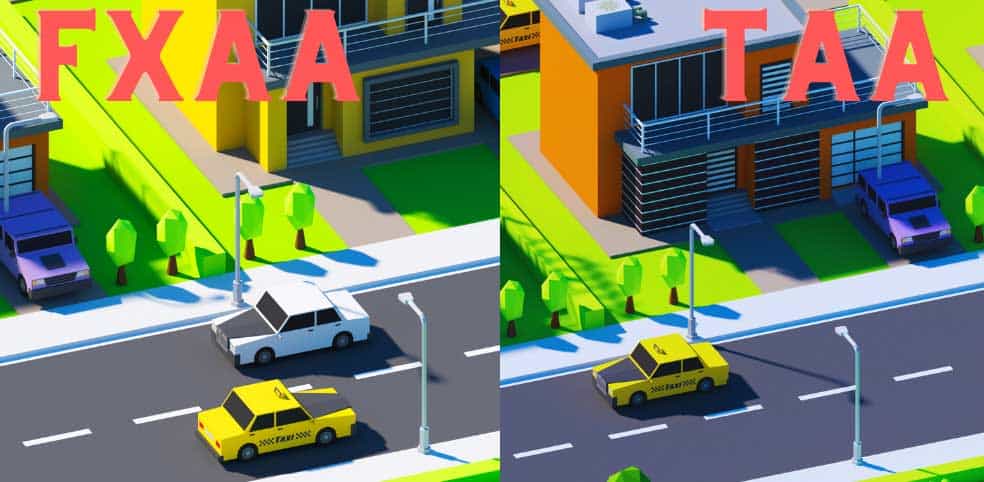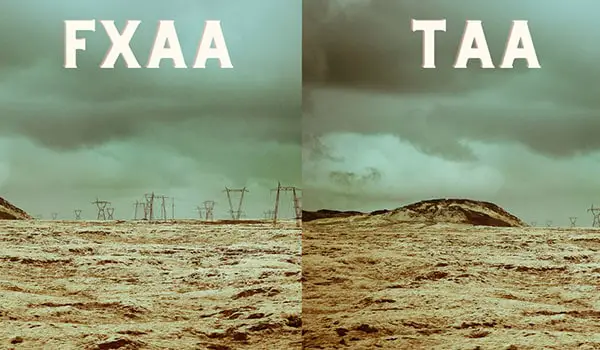Choosing between FXAA and TAA depends on your system’s capabilities and personal preference for image quality vs. performance. Some gamers prefer the sharpness of FXAA despite its limitations, while others appreciate the smoother visuals TAA provides.
Some modern games also offer combinations of both or let players use other AA methods in tandem with these for enhanced visuals. Experimenting with each game’s settings will help determine what looks and performs best on your system.
FXAA Vs TAA (Pros and Cons)
Both FXAA (Fast Approximate Anti-Aliasing) and TAA (Temporal Anti-Aliasing) are anti-aliasing techniques used to reduce the appearance of jagged edges (“jaggies”) in video games and other graphical applications. They aim to make the visuals smoother and more appealing. However, they work in different ways and come with their own sets of pros and cons.
Here’s a comparison of FXAA and TAA:
| Feature/Aspect | FXAA | TAA |
|---|---|---|
| Basic Function | Analyzes the rendered frame and smooths edges by applying a form of post-process shader. | Blends frames over time to produce a smooth output. It leverages data from previous frames to reduce flickering and jaggies. |
| Performance | Generally faster. Minimal performance hit. | Can be more demanding than FXAA due to the need to reference multiple frames. |
| Image Quality | Can make the image appear slightly blurry, especially noticeable on text. | Produces smoother images, but can introduce a softness or slight blurriness. Can be especially effective against moving objects. |
| Implementation | Easier to implement and is often included as an option in many games because of its low overhead. | More complex to implement due to its temporal nature. Some games might not support it or have limited support. |
| Edge Detection | Less accurate as it’s a post-process technique and doesn’t have information about the 3D geometry of scenes. | Can be more accurate as it leverages data from multiple frames. |
| Compatibility | Almost universally compatible with different games and applications. | Requires the game engine to support temporal techniques, which might not always be the case. |
| Artifacts | Less prone to artifacts related to moving objects or screen motion. | Might introduce ghosting artifacts, especially when objects or the camera moves quickly. |
Detailed Explanation:
FXAA (Fast Approximate Anti-Aliasing):
FXAA is a post-processing anti-aliasing method that applies the anti-aliasing after the image is rendered. It scans the entire screen for edges and tries to smooth them out. Because it doesn’t consider the depth or vector information of the scene, it might not be as accurate in its edge detection. It’s computationally light, making it a favorite for those who wish to retain performance.
TAA (Temporal Anti-Aliasing):
TAA is more advanced and utilizes multiple frames to achieve its results. It compares the current frame with the previous one to identify and smooth out jagged edges. This approach can lead to a smooth image, which is particularly beneficial in motion or moving objects.
However, TAA can sometimes introduce ghosting effects, especially when there’s rapid motion. It’s also more computationally demanding than FXAA.
In practice, the best anti-aliasing method will depend on the application or game and the hardware used. Some games even allow users to combine multiple methods for improved results. Always adjust settings and test different methods to see which balances visual quality and performance best.
FXAA Vs TAA PUBG
“PUBG” (PlayerUnknown’s Battlegrounds) is a popular battle royale game where visual clarity can provide a competitive advantage. The game has been optimized over the years, and both FXAA and TAA have been options for anti-aliasing in its settings. Here’s a comparison of FXAA and TAA specifically in the context of “PUBG” and ”Honkai Star Rail”:

| Feature/Aspect | FXAA in PUBG | TAA in PUBG |
|---|---|---|
| Basic Function | A post-process method that smooths edges after rendering. | Uses multiple frames to produce smoother visuals. |
| Performance | Typically offers better frame rates than TAA in PUBG. | Typically, it offers better frame rates than TAA in PUBG. |
| Image Quality | Can make distant objects and text somewhat blurry. | Provides a smoother image, but can introduce a bit of softness. In PUBG, this can make distant players slightly harder to spot in certain scenarios. |
| Visibility | Since it’s less aggressive, some players prefer it for spotting enemies at a distance despite the potential for minor jaggies. | While it smooths out jaggies effectively, the slight blur can be a disadvantage when spotting distant players, especially when they’re hiding in foliage. |
| Artifacts | Less prone to artifacts. | In fast-paced movements or when panning the camera quickly, there might be some ghosting or shimmering effects. |
| Popularity in Community | Some competitive players prefer FXAA for the slight visibility advantage. | Players who prioritize visual aesthetics might prefer TAA for its overall smoother visuals. |
Ultimately, the choice between FXAA and TAA in “PUBG” will depend on a player’s preferences and priorities. Experiment with both settings in various scenarios within the game to determine which one aligns best with your playstyle and system capabilities.
FXAA Vs TAA FPS
If you’re looking to compare FXAA and TAA in terms of how they impact FPS (frames per second) in a general sense, here’s a table:

| Feature/Aspect | FXAA | TAA |
|---|---|---|
| Basic Function | Post-process method that smooths edges after the frame is rendered. | Uses data from multiple frames to produce smoother visuals. |
| Performance Impact | Typically, it has a minor impact on FPS due to its simplicity. | Generally more demanding on the system, which can result in a more noticeable FPS drop. |
| Image Quality | May produce slightly blurrier visuals, especially on fine details like text. | Offers smoother visuals, but can introduce some softness or blur. |
| Compatibility | Nearly universally compatible with various games and graphics cards. | Require more from the game engine and graphics card to implement properly. |
| Artifacts | Rare artifacts, generally offers consistent output. | Can sometimes produce ghosting or other artifacts, especially during rapid motion. |
| Preferred Use | When aiming for maximum FPS, especially on older hardware. | When a balance between higher visual quality and performance is desired. |
In practice, the actual FPS impact of each method can vary based on the specific game, the graphical settings used, and the hardware in play. Always adjust settings and test different methods to see which offers the best balance for your system and gaming preferences.
Learn More:
Does Having Multiple Monitors Affect FPS?
Do Live Wallpapers Affect FPS?
Does Overclocking Reduce GPU Lifespan?
Table of Contents
